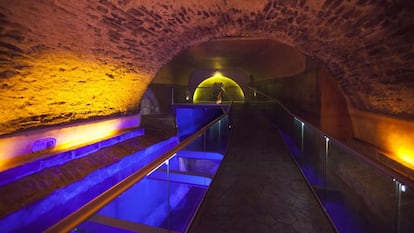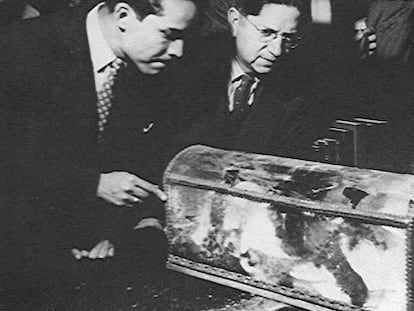How a Mexican city discovered its long-forgotten ancient tunnels
For decades the secret passageways in Puebla were nothing more than a rumor

It was a legend that was often told at the dinner table or during discussions in bars. Under the city of Puebla, there was a network of tunnels connecting churches with ancient buildings, and they were used as escape routes by Mexican revolutionaries during the war.
But there had never been any trace of these secret passageways, not even a map to prove their existence, until now.
A network of 10 kilometers of underground roads built in the 16th, 17th and 18th centuries have been found in the center of the city. Local government officials have now begun to study them with the aim of shedding some light on their history.
There had never been any trace of these secret passageways, not even a map, until now
The first indications of their existence were seen in a series of 19th-century maps that belonged to a family in the area. But the real proof came in 2014, when workers accidentally found part of an underground structure during an urban remodeling project.
Little by little the semi-circular vaults of the canals were discovered underneath the earth, and their almost perfect symmetry was revealed.
“We never thought that they would be like this, says Sergio Vergara, the manager of Puebla’s historic center. “I have never seen anything like this in all my career.”
Preliminary studies show that the tunnels were constructed after the city was founded in 1531.
Puebla was one of the first cities settled during the Spanish colonial era, and became an important center for the Catholic clergy.
Real proof came in 2014 when workers accidentally found part of an underground structure during an urban remodeling project
The underground passageways were built during the next two centuries at the same time as the majority of churches, monasteries and the other emblematic buildings in the city, such as City Hall and the Cathedral.
The subterranean roads served principally so that that Catholic Church’s treasures could be discreetly transported from one place to another.
The passageways feature different architectural styles, reflecting the time of the construction. So far, 15 different archway systems built to support the structures have been found. For example, builders used a type of cement composition made with stone chips and other materials to fashion a half-way arch.
“It was precision work,” say Vergara.
Throughout all these years, the structures have resisted the weight of the buildings, water systems, earthquakes and the traffic above ground.
The entrance to the first of nine tunnels – called the Puerta de Zaragoza – will be opened to visitors in February. It is located in Xanenetla neighborhood, in the northeast of the city.
The vaults there at one time measured 8.5 meters in height and ran across for about four kilometers from the San Francisco River to Fort Guadalupe, which was built on a hill to protect the city from attacks.
The subterranean roads served principally so that that Catholic Church’s treasures could be discreetly transported from one place to another
The details support the theory that the underground passage was used to transport weapons, ammunition and soldiers during the now-commemorated battle that took place on May 5, 1862 when Mexicans repelled an invasion of French soldiers sent by Napoleon III.
The tunnels were also used to attack the French on different fronts at the time of the invasion.
“My grandfather use to tell me these stories and had personally seen some of the tunnels,” says Puebla Mayor Antonio Gali. “He said, ‘I saw Porfirio Díaz [a Mexican revolutionary who later became president], who crossed on horseback, and wagons would pass through the vaults in the city’.”
After the 1910 Mexican Revolution, the tunnels were forgotten but they lived on thanks to stories of the past.
“With so many years of history I can’t imagine why no one took the time to try to find them,” says Mayor Gali.
English version by Martin Delfín.
The bubonic plague bridge

During the restoration of the underground tunnels investigators also found the ancient remains of the Puente de Bubas, a bridgelike structure from the 17th century that was used to cross the San Francisco River, which was the main water source for the city in that era.
The river was channeled in the 1960s and the remains of the bridge stayed buried under an old home.
Puente de Bubas was given its name because it was used by Franciscan priests to reach the hospital where they cared for patients suffering from the bubonic plague.
Also discovered at the same site was an ancient crest of the city of Puebla made of stone. The coat of arms was ordered by the Spanish king in 1790.
The bridge, which has been remodeled, has been open to the public since December.
Tu suscripción se está usando en otro dispositivo
¿Quieres añadir otro usuario a tu suscripción?
Si continúas leyendo en este dispositivo, no se podrá leer en el otro.
FlechaTu suscripción se está usando en otro dispositivo y solo puedes acceder a EL PAÍS desde un dispositivo a la vez.
Si quieres compartir tu cuenta, cambia tu suscripción a la modalidad Premium, así podrás añadir otro usuario. Cada uno accederá con su propia cuenta de email, lo que os permitirá personalizar vuestra experiencia en EL PAÍS.
En el caso de no saber quién está usando tu cuenta, te recomendamos cambiar tu contraseña aquí.
Si decides continuar compartiendo tu cuenta, este mensaje se mostrará en tu dispositivo y en el de la otra persona que está usando tu cuenta de forma indefinida, afectando a tu experiencia de lectura. Puedes consultar aquí los términos y condiciones de la suscripción digital.











































